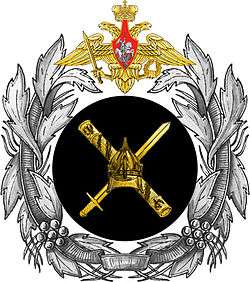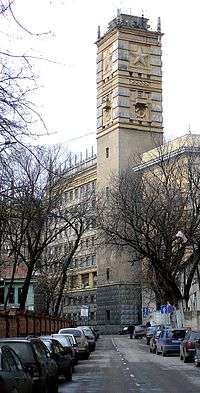General Staff of the Armed Forces of the Russian Federation

The General Staff of the Armed Forces of the Russian Federation (Russian: Генеральный штаб Вооружённых сил Российской Федерации, Генштаб – Genshtab) is the military staff of the Armed Forces of the Russian Federation. It is the central organ of the Armed Forces Administration and oversees operational management of the armed forces under the Russian Ministry of Defence.
As of 2013 the Chief of the General Staff is Army General Valery Gerasimov.
General Staff is located in Moscow on Znamenka Street in the Arbat District. Together with the Ministry of Defence building and several Staff directorate office buildings nearby, it forms the so-called "Arbat military district" as it is often referred to among the military personnel to outline the highest supreme command of the Russian Armed Forces.
History

In the Soviet Armed Forces, the Soviet General Staff acted as the main commanding and supervising body of the military. The Red Army Staff was first formed in 1921 but, historian John Erickson says, until 1924 developed into an unwieldy grouping dealing with combat training, routine Red Army affairs, and defence policy, all without real definition Erickson dates the development of the Staff as the Soviet 'military brain' from Mikhail Frunze's appointment to the post of Chief of Staff by Order No.78 of 1 April 1924. 'From this date.. the history of the Soviet General Staff – as it was to become – begins'.[1]
On 22 September 1935, the authorities renamed the RKKA Staff as the General Staff, which essentially reincarnated the General Staff of the Russian Empire.[2] Many of the former RKKA Staff officers had served as General Staff officers in the Russian Empire and became General Staff officers in the USSR. General Staff officers typically had extensive combat experience and solid academic training.
William Odom wrote that 'during World War II [the General Staff] became Stalin's main organ for operational direction of all military forces. After the war it became the most powerful centre for virtually all aspects of military planning, operations, and determination of resource requirements. The minister of defence had only a limited staff for his own support, leaving him heavily dependent on the General Staff. … Within the Ministry of Defence, all the resource allocation issues were normally resolved by the chief of the General Staff before going to the minister, and finally, after consultation with GOSPLAN, to the Politburo.'[3]
During the Cold War, the General Staff maintained Soviet plans for the invasion of Western-Europe, whose massive scale was made known secretly to the West by spies such as Ryszard Kukliński and later published by German researchers working upon the National People's Army files,[4] and the Parallel History Project[5] and the associated Polish exercise documents, Seven Days to the River Rhine (1979).
Since the dissolution of the Soviet Union and especially since 2004 the General Staff and the Russian Ministry of Defence have attempted to divide direction of the armed forces between them, often in intense bouts of bureaucratic disagreement. It has been reported that the General Staff's main role now is that of the Russian Ministry of Defence's department of strategic planning, and the Minister of Defence himself is now gaining executive authority over the troops. However some Russian commentators dispute this.[6]
General Staff organization
- Main Directorate of Communications[7]
- Main Operational Directorate[7]
- Main Intelligence Directorate[7]
- Main Organizational Mobilization Directorate[7]
- Directorate of the Chief of Radioelectronic Combat Troops[7]
- Military Topographical Directorate[7]
- Main Command – Ground Troops[7]
- Main Command – Navy[7]
- Main Command – Air Forces[7]
- Aerospace Defense Command[7]
- Strategic Missile Troops Command[7]
- Airborne Troops Command[7]
- Special Operations Command
- Operational Training Directorate[7]
- 8th Directorate[7]
- 12th Main Directorate[7]
- Troop service and safety of military service Directorate[7]
- Directorate of the Chief of the Radiation, Chemical, and Biological Defense Troops[7]
- Directorate of the Chief of Engineering Troops[7]
- Main Directorate for Deep Sea Research[7]
- Central Command Post[7]
- Hydrometeorological Service[7]
Notes
- ↑ John Erickson, The Soviet High Command 1918–1941: A Military-Political History 1918–1941, St Martin's Press (Macmillan), London, 1962 (1964?), pp. 173, 203–204, 796.
- ↑ See Philip Bayer, Evolution of the Soviet General Staff 1917–1941, New York, Garland, 1987
- ↑ Odom, The Collapse of the Soviet Military, Yale, 1998, p. 27.
- ↑ Odom, William E. (1998). "The Collapse of the Soviet Military". Yale. pp. 72–80.
- ↑ http://www.php.isn.ethz.ch/collections/colltopic.cfm?lng=en&id=14944&nav1=1&nav2=2
- ↑ Pavel Felgenhauer, "Russia's Imperial General Staff", Perspective, Volume XVI Number 1 (October–November 2005)
- 1 2 3 4 5 6 7 8 9 10 11 12 13 14 15 16 17 18 19 20 21 RF MOD website www.mil.ru
Further reading
- Захаров М.В. Генеральный штаб в предвоенные годы. — М.: Воениздат, 1989
Zakharov, M.V. General Staff in the pre-war years, Moscow, Voenizdat., 1989 (chapter 6)
External links
- Dr S. J. Main, The "Brain" of the Russian Army: The Centre for Military-Strategic Research, General Staff, 1985–2000, Conflict Studies Research Centre, UK MOD
Coordinates: 55°45′02″N 37°36′10″E / 55.75056°N 37.60278°E